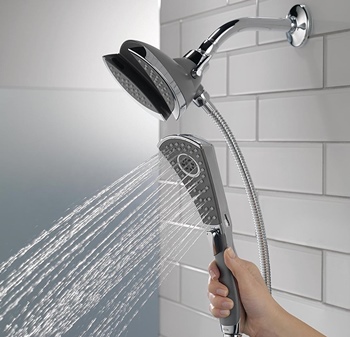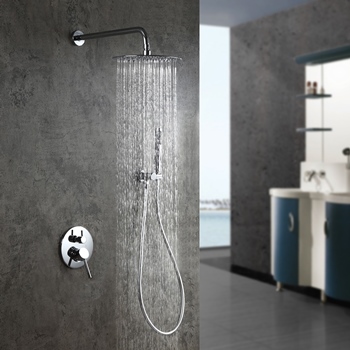Setting up a bathroom is no easy task. If we take into account that the plumbing is set, people usually opt to set up the rest of the bathroom elements on their own. For the most part, these finishing touches are not done to save money, but to adapt the bathroom to the people who are going to use it. After all, we go to the bathroom at least once a day, so why not make the necessary adjustments to make the experience pleasant.
One such finishing task is setting up the shower head. There is nothing more tedious than having to shower under a shower head that is too tall or too short. So, for the sake of making you showering experience perfect, here’s a short guide on how far up you should put the shower head. Let’s get right into it!
Standard Shower Height – Is There Such A Thing?
 If we were to talk about standards around the world (when it comes to shower heads, of course), finding a consensus wouldn’t be an easy task. Not only that different areas have different standards – even various states have some sort of nuance to this whole concept.
If we were to talk about standards around the world (when it comes to shower heads, of course), finding a consensus wouldn’t be an easy task. Not only that different areas have different standards – even various states have some sort of nuance to this whole concept.
One thing is certain – a shower head needs to be at least three inches from the top of your head. But, having a shower head with adjustable height is not something we can all afford (space-wise) at our homes, especially people who live in a household with more than two people. The chances of you all being the same height are astronomical and shared living spaces are all about compromise.
So, what gives?
Well, plumbers all around the world usually install a shower at the height of 80”, which is fine in most cases. However, if the shower head is too tall for you, you can miss out on all sorts of different features those multipurpose shower heads have to offer.
The Size of an Average Shower
The shower area, also known as the shower chamber, is the space that includes everything that a standard shower needs to work properly. Top to bottom, we can include:
- Walls coated in waterproof materials or tiles
- A floor with proper drainage
- A screen or a shower curtain
- A shower hose or a water pipe, depending on the type
- A proper shower head
Anything else added to this is considered an extra feature, which is always welcome but not exactly necessary. The surface of a shower should be at least 36 x 36 inches, but people usually opt for larger shower spaces that can fulfill the needs of all people using it. Now, you might think that shower height is not that important, but that is not exactly true.
Shower Height and Ventilation
The height of the shower chamber around the world vary, but one factor remains the same – no shower chamber should be installed to reach the ceiling. Even though it seems logical, if the shower goes all up to the ceiling, it will cut off the ventilation, and no fresh air will be able to get in. Most importantly, the hot water will not be able to get out through the vent, so it starts going through the microscopic cracks between the tiles, thus leading to severe water damage down the line.
There are shower chambers that reach the ceiling out there and these high-end showers come with special ventilation systems. If you own such a shower at home, you don’t have to worry about water damage all that much.
Handheld (barred) Shower Head
 Most-commonly seen in Europe, the handheld shower head is among the most efficient shower heads for households with a lot of people living in. A lot of parents opt for a handheld shower head system simply due to the fact that it can be adjusted to anyone, from a toddler to a super-tall person.
Most-commonly seen in Europe, the handheld shower head is among the most efficient shower heads for households with a lot of people living in. A lot of parents opt for a handheld shower head system simply due to the fact that it can be adjusted to anyone, from a toddler to a super-tall person.
This type of shower head usually comes with a metal bar. The bar is installed vertically over the faucet (or the shower valve) and it allows the shower head to be moved up and down the bar easily. When it comes to the typical height of a handheld shower head system, we are talking about 72 to 80 inches.
However, if you do go for a barred system, practically speaking, there is no limit on how long the bar should be. Essentially, you get to choose the height, even if it’s lower than the standard 72 inches.
You should keep in mind that this type (and height) of shower heads require super-flexible hoses that can withstand being yanked and twisted all the time.
Rain Shower Head
I have to admit that this type of shower head is my favorite. There is nothing better than stepping under a rain shower after a hard day’s work. The rain shower head is known to have the biggest spread, despite the fact that the amount of water used is the same as with any other type.
But, to fully experience the rain, you should install the rain shower head at a height of at least 80 inches. If you put it too low, you won’t be able to feel the entire spread on your body while you are underneath it. On the other hand, if you set it high enough, the rain shower head will be able to fulfill everyone’s needs, unless we are talking about extremely tall people.
I’d recommend that, if your shower size allows it, you go with the 84 or even 86 inches. Keep in mind that the spread is quite wide, so make sure it doesn’t go over the shower walls, curtain, or screen.
Wall Mounted (fixed) Shower Head
 A wall mounted shower head is typical for the US. This type of shower head is usually fixed, meaning that there isn’t much space there for adjustments after it is installed. To accommodate your housemates and future guests, I recommend going with at least 80 inches.
A wall mounted shower head is typical for the US. This type of shower head is usually fixed, meaning that there isn’t much space there for adjustments after it is installed. To accommodate your housemates and future guests, I recommend going with at least 80 inches.
Also, keep in mind that you should leave at least three inches between the shower head and the ceiling. If you own a compact shower chamber, try changing the angle, setting the spread and spray to aim downwards.
Wrap Up
People often think that small home adjustments require a professional. This is rarely the case. All you need is proper tools (sometimes not even that) and some patience to adapt the shower head to your particular needs. I always encourage people to try and fix stuff around the bathroom themselves, but hey – if you think you can’t handle it, there is no shame in asking for professional help. Sometimes, you can’t spare the time to bother with bathroom fixing, and that is fine.
I hope that this small guide manages to help you set up your shower head, allowing you to make your bathroom into a place of relaxation and peace. No one should have trouble with an incorrectly placed shower head, and neither should you! I always say – the key to a comfy home is in the small details like the height of the shower head. Enjoy your showers!